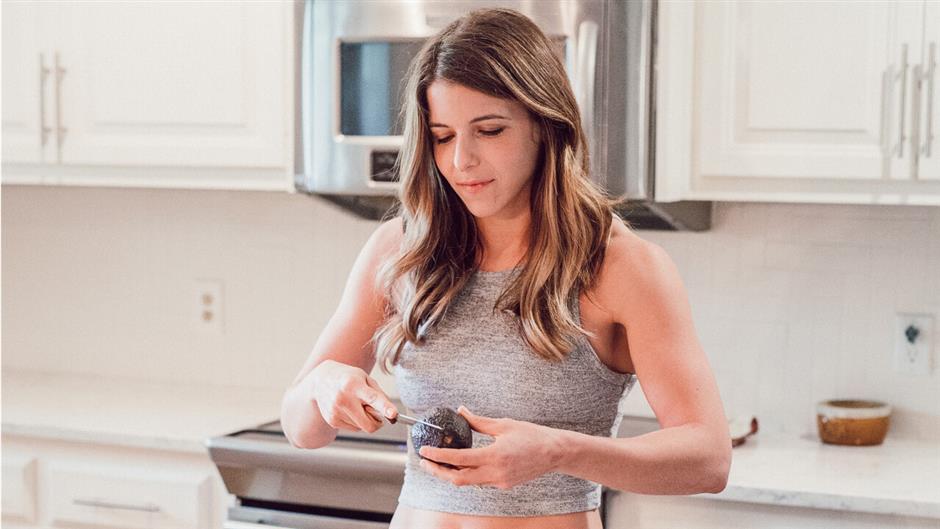
It’s natural for people to want an easy button. Following the path of least resistance is a really intelligent way of approaching things. And there’s no exception when it comes to nutrition, weight loss and wellness.
It’s safe to say that if we were given two options
Option 1: Snap your fingers and have the body and life you love.
Option 2: Work hard to eat right, exercise and build discipline around difficult scenarios to have the body and life you love.
We would all choose option 1.
Advertisement
I’ve been working on the “snap your fingers” program but there are a few kinks in the model and unfortunately, for now, that’s not the reality of our situation.
If there’s one thing we’ve learned over the past five and a half years working with tens of thousands of people, it’s that nutrition is complex. Not just because there are so many options out there with conflicting evidence, but also because it is so uniquely tied to our emotions, our memories and the way we feel about ourselves.
So if there’s so much information out there and no easy way to go about it, you might be thinking:
I want to make sure I am putting my time, attention and effort toward something that’s going to work for me. What is the best diet?
Let’s unpack this a little deeper.
Advertisement
At WAG, we often say things like, “The best diet is the one that you can follow even in the harshest of circumstances.” We’ve spent over half a decade trying to discover what that best diet is and have successfully helped thousands of individuals find it. Here’s what we’ve consistently found.
THE BEST DIET
- Includes foods you enjoy
- Achieves your body composition goals (maintenance, weight loss or weight gain)
- Can be followed during moments of high emotion (celebrations, breakups, losing a job, etc.)
- Keeps your body, mind and soul healthy and thriving
- Allows you to perform physically, mentally and emotionally at your best
- Can be followed during times of transition (moving homes, changing professions, travel, etc.)
- Has a suitable amount of structure and flexibility for your personality and lifestyle
When putting any diet up against these standards, it’s bound to fall short to someone. For every person that absolutely loves the ketogenic diet, there’s going to be another that feels better suited to a higher carb approach. When you find someone that swears by a paleo approach, you’ll find another person that achieves better results with something more structured.
To make matters even more confusing, the best diet for you right now is unlikely to be the best diet for you forever.
You might start a job that requires shift work and leaves you with less time to cook. You might get pregnant and your needs must adjust with your growing baby. You might move to a new place and lose access to a lot of your usual foods. Something we have also seen often is that a diet that helped you lose the first 30 lbs may not work when trying to lose the last 10.
So what do we do?
Advertisement
I have good news and bad news. I’ll start with the bad news.
In order to find the best diet for you it’s going to take time, experimentation and discipline. There’s no way around it—only for the rare human unicorn is this easy.
Through this process, we’ve found that individuals often discover skills they didn’t know they had, likes they thought were dislikes and are surprised by how much better they feel when they thought they felt great already.
The good news: Going through the process of discovering the diet that’s best for you builds self-awareness and a set of tools for your toolbox that you’ll never lose. This is a lot like riding a bike: Once you learn to ride a bike, you can pick it back up, even years later.
I mentioned earlier how we’ve found that the best diet for you now isn’t always the best diet for you forever. Gaining the ability to find what’s best for you right now is not something you will lose. You’ll be able to pick your “finding the best diet for me” skills back up whenever you need them.
Advertisement
Imagine in the future you or someone you know becomes sick. Your doctor suggests that a low carb approach would be the best for your health and recovery—this is your new “best diet” for the moment
If you have taken the time to experiment with your nutrition and build discipline around changing it, you’ll feel confident that you can implement the change and follow through. For those that have never built their “finding the best diet for me” skills, it will be much more difficult to make changes that they can sustain.
So, how do you go about finding the best diet for you right now?
In an attempt to provide some clear steps you can follow to figure out your best diet, I’m going to give a few options for ways to go about this. There are many ways you can begin the process of finding what’s best for you and below I will outline a few that can be very successful.
1. Create a Tournament for Diets
I was listening to the Brute Strength Podcast hosted by Michael Cazayoux and, on this episode, Dr. John Berardi of Precision Nutrition was on the show talking about this concept, which really hit home for me.
Advertisement
Michael and John were talking about having a goal and realizing that there are 10, 20, 50 things you need to do in order to achieve that goal. Michael asked, “How do you know where to start?” and John went on to talk about this process he called “creating a tournament.”
He described listing out all the skills you need to develop in order to achieve a goal and writing them into a bracketed tournament that pits them against each other. Starting with the round robin, continuing with the quarterfinals, then the semifinals and finally ending with your champion.
It struck me that this could be done with diets as well. This is what it would look like.
On the left you have listed all the diets you can try and as you move closer and closer to the right you narrow the options down until there is a winner. You are pitting diets against each other and assessing their efficacy for you until one wins out.
For example:
Advertisement
Ketogenic Diet vs. Flexible Dieting
Keto
How it works:
- The ketogenic diet involves following a high fat and low carbohydrate protocol. Carbs will often be as low as 10–15% of total calories.
- Protein intake is on the lower end (around 20–25 percent of total calories).
- Keto changes the way the body produces and utilizes energy. Because carb intake is so low, glycogen stores drop and the body will use fat for energy instead (this is called being “fat adapted”).
Pros:
- Simplicity. Clear guidelines around which food items classify as keto and which do not.
- Does not allow for sugar or processed grains, which helps some people kick a sugar/junk food habit.
- May provide a clear mental state without dips in focus.
- May provide increased energy and improved recovery (no energy spikes or crashes because you are not relying on carbs for fuel).
- Could help people who have struggled with fat loss or body composition changes thanks to higher levels of satiety and minimal hunger.
- Great for people who prefer higher fats in general.
- Could help people with a history of seizures. The keto diet has a long history of use for reducing seizure activity (first consult with your healthcare provider, of course).
- Could benefit people with neurodegenerative disorders (such as multiple sclerosis, Parkinson’s and Alzheimer’s) or people who have experienced traumatic brain injury from events such as explosions or concussions.
- Can benefit people with insulin resistance or type 2 diabetes.
- Can benefit people with gluten intolerances (since many foods containing gluten could kick a client out of ketosis and therefore need to be avoided).
- Can benefit people with joint inflammation because keto requires a reduction in highly inflammatory processed sugars, high glycemic foods and processed fats. Keto encourages increased consumption of anti-inflammatory foods.
- May be easier to follow for people who travel frequently for work (because it is often easier to find higher-fat items in restaurants than lower-fat choices).
Cons:
- Major commitment and shift in lifestyle. Very strict with minimal flexibility. May be difficult to sustain long term.
- May experience “keto flu” upon transitioning to keto (low energy, headaches, brain fog, etc.).
- To test your ketone levels (to determine whether you’re in ketosis), you’ll have to purchase a blood test kit, urine test strips or a breathalyzer.
- Keto may not be a good idea for type 1 diabetics, pregnant women, someone trying to bulk up or put on mass, vegetarians, vegans or someone with a history of an eating disorder (due to keto’s high level of required precision and restrictive thinking).
Flexible Dieting
How it works:
- With flexible dieting, no food is completely off limits. Instead, this protocol promotes moderation.
- Many flexible dieters track their food using an app such as MyFitnessPal to ensure they hit their daily protein, carb, fat and fiber goals.
Pros:
Advertisement
- Gives a lot of structure/insight around how much you’re eating (carbs, fats, protein and calories), which can make adjustments to achieve goals easier.
- Is very flexible (hence the name) and is meant to form around your lifestyle so that you can get results while also still eating the things you love and participating in important experiences.
- Many people find it sustainable over long periods of time.
- Can be very useful for achieving weight loss or body composition goals.
Cons:
- Often requires a food scale to weigh and measure your food for best results, which can feel tedious for some.
- May not offer enough structure for people who prefer clear-cut rules and boundaries.
- Can be easy to fit processed foods without much micronutrient value into your day.
When looking at these two diet styles and considering our “BEST DIET” standards we listed above, ask yourself: Which one do you think better suits your lifestyle and your preferences? There’s no right or wrong answer, but one does need to win because we need to know what next actions we can take.
Eventually you end up with a winner, which will remove a lot of the overwhelm and anxiety from having so many options to choose from. This doesn’t mean you have to stick with that diet forever—it’s simply a system to decide where to START.
If the ketogenic diet ends up being your winner, you can start there and truly commit to seeing if this is the right choice for you.
IMPORTANT NOTE: Once you have made a commitment, the way to find out if it truly works is to give it time.
Advertisement
This is different than trying it for a week, struggling and giving up.
You may not be able to follow it extremely well when you’re just starting on your journey, so give it time to settle in, for your body to adapt and then make a decision to either stay the path or switch once you’ve given it a fair shot.
My suggestion would be to give any new approach 60 to 90 days—closer to 90 days if you have problems with adherence in the beginning.
Other diets you might want to put in your tournament:
Paleo
How it works:
Advertisement
- The paleo (or primal) diet is based on the idea that humans adapted to eat particular kinds of foods, and in order to stay healthy, strong and fit, we need to eat like our ancestors.
- It involves eating meat (and often all parts of the animal, including organs, bone marrow and cartilage), fish, fruits, vegetables, nuts and seeds—foods that, in the past, could be obtained by hunting and gathering.
- Paleo does not allow starchy carbs (such as rice and potatoes), dairy or legumes.
Pros:
- Mostly clear* guidelines around which foods classify as paleo and which do not, making the protocol simple (*there’s some disagreement around which foods classify as paleo; see more below in the list of “Cons”).
- Very focused on high-quality, nutrient-dense whole foods, which is a massive improvement over the average Western diet.
- Somewhat flexible. Still allows for some “sweet treats” (but they must be made with paleo-friendly sweeteners).
- Likely effective for improving several chronic diseases.
Cons:
- May feel too restrictive for some people, which could negatively impact long-term sustainability.
- Does not provide guidelines around calorie intake. Basically, if it is paleo, you can have it. This could negatively impact weight loss or body composition goals.
- There are some disagreements regarding which foods are considered “paleo,” which could create confusion (for example, some groups recommend avoiding legumes and some say they are acceptable if soaked overnight).
The Zone Diet
How it works:
- The Zone Diet, developed by Dr. Barry Sears, is a systematic diet plan where the main goal is to be “in the zone.” It encourages eating a certain amount of protein, carbs and fat at every meal in order to reduce inflammation in the body, among other health benefits.
- Involves more structure than just eating foods that are “Zone” or not: Calories must be consumed in the following ratio: 40% carbs, 30% fat and 30% protein.
- Utilizes measuring and weighing food to satisfy daily needs. Food is classified into “blocks” of each macronutrient. This allows control of total calories, which can help with weight loss.
- There’s restriction of certain foods such as refined carbs, starchy vegetables, processed grains and higher-sugar fruits.
Pros:
- No emphasis on restriction or complete ban of foods.
- Promotes a focus on nutrient-dense foods (lean protein, fruits and veggies).
- Can help you learn portion sizing, which can lead to a healthy weight naturally.
Cons:
Advertisement
- Can be confusing to figure out where to start and how many blocks to eat.
- Relies initially on listening to “hunger cues” and adjusting blocks accordingly (which may slow down weight loss or body composition change efforts).
- Lacks peer-reviewed research to back up some claims.
- May feel too restrictive for those who enjoy grains, higher-sugar fruits and sweets occasionally, which could affect adherence.
- Could be difficult in social situations to explain the idea behind “blocks” if people ask questions.
2. Create a Tournament for Nutrition Habits
You can follow the same process as above with a list of skills, habits and behaviors you believe might help you achieve your goals. Some examples might be:
- Eat more vegetables.
- Exercise more.
- Have sugar only once a week.
- Cook two to three meals a week at home.
- Prep food for the week at home.
- Say no to food in the breakroom at work.
- Drink only one alcoholic beverage a week.
- Drink more water.
All of these skills and behaviors can help you achieve your goals and also find a protocol that’s best for you; however, you can’t effectively implement all of them into your life at once. Pin these things against each other until you end up with a winner, or in this case, at the semifinals use the last two as your first step.
4. Get a Coach
A coach that has had experience implementing many different nutrition protocols with different people can be a great sounding board and guide for you in discovering what’s best for you.
A coach is an objective third party that can assess your results without the same emotion that you will automatically have attached to it. They can also choose that next step for you to try instead of you needing to make that decision. You can save all that energy for the hardest part, which is taking action and following through.
At Working Against Gravity, we are dedicated to this work of finding what the best nutrition program is for you. We work with you one-on-one to track your data (weight, mood, energy, sleep, stress, hunger and overall wellness) and make sure that the changes we are implementing in your life are actually getting you the results you’re looking for.
Advertisement
As you can see already, finding the best diet is no simple task. So while I work on the finger-snapping technique that gets you results in an instant, I suggest getting right into the messy middle and taking action!
One thing that I know for certain is that action is what you need to get results.
Schedule a Free Intro Call
Working Against Gravity has led the macro tracking and health space for over a decade. Our team doesn’t just understand the science of nutrition—we’ve spent years mastering the art of tailoring it to fit your life. That means no cookie-cutter plans, just real strategies that have worked for over 30,000 people.
Schedule a free call with our team to learn how working with a 1-on-1 WAG coach will help you reach your goals.



